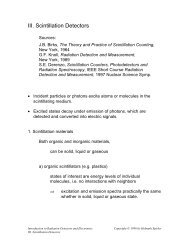Introduction to radiation-resistant semiconductor devices and circuits
Introduction to radiation-resistant semiconductor devices and circuits
Introduction to radiation-resistant semiconductor devices and circuits
Create successful ePaper yourself
Turn your PDF publications into a flip-book with our unique Google optimized e-Paper software.
have been obtained on fully irradiated strip detec<strong>to</strong>rs read out by LHC compatible<br />
electronics. (21)<br />
The basic detec<strong>to</strong>r is insensitive <strong>to</strong> ionization effects. In the bulk, ionizing<br />
<strong>radiation</strong> creates electrons <strong>and</strong> holes that are swept from the sensitive volume;<br />
charge can flow freely through the external circuitry <strong>to</strong> res<strong>to</strong>re equilibrium. The<br />
problem lies in the peripheral structures, the oxide layers that are essential <strong>to</strong> controlling<br />
leakage paths at the edge of the diode <strong>and</strong> <strong>to</strong> preserving inter-electrode<br />
isolation in segmented detec<strong>to</strong>rs.<br />
The positive space charge due <strong>to</strong> hole trapping in the oxide <strong>and</strong> at the interface<br />
(see Fig. 2) attracts electrons in the silicon bulk <strong>to</strong> the interface. These accumulation<br />
layers can exhibit high local electron densities <strong>and</strong> form conducting channels,<br />
for example between the detec<strong>to</strong>r electrodes. This is especially critical at the<br />
“ohmic” electrodes in double-sided detec<strong>to</strong>rs, where the absence of pn junctions<br />
makes operation rely on full depletion of the silicon surface (even without <strong>radiation</strong>,<br />
the silicon surface tends <strong>to</strong> be n-type, so the ohmic side of n type detec<strong>to</strong>rs is<br />
inherently more difficult <strong>to</strong> control). (22,23)<br />
Some detec<strong>to</strong>rs include integrated coupling capaci<strong>to</strong>rs <strong>and</strong> biasing networks.<br />
Biasing structures such as punch-through resis<strong>to</strong>rs <strong>and</strong> MOSFET structures are<br />
subject <strong>to</strong> ionization damage. Although these <strong>devices</strong> can remain functional, substantial<br />
changes in voltage drop have been reported for punch-through <strong>and</strong> accumulation<br />
layer <strong>devices</strong>, whereas measurements on polysilicon resis<strong>to</strong>rs irradiated <strong>to</strong><br />
4 Mrad (65 MeV p) show no effect. (24)<br />
Radiation Damage in Transis<strong>to</strong>rs <strong>and</strong> Integrated Circuits<br />
In principle, the same phenomena discussed for detec<strong>to</strong>rs also occur in transis<strong>to</strong>rs,<br />
except that the geometries of transis<strong>to</strong>rs are much smaller (depletion widths<br />
10 15 cm -3 ).<br />
Bipolar Transis<strong>to</strong>rs<br />
The most important damage mechanism in bipolar transis<strong>to</strong>rs is the degradation<br />
of DC current gain at low currents. The damage mechanism is the same that causes<br />
increased leakage current in detec<strong>to</strong>rs, formation of mid-gap states by displacement<br />
damage. The difference is that the base-emitter junction is forward biased, so<br />
the high carrier concentration in the conduction b<strong>and</strong> tips the balance from generation<br />
<strong>to</strong> recombination (see Fig. 1). The fractional carrier loss depends on the<br />
relative concentrations of injected carriers <strong>and</strong> defects. Consequently, the<br />
reduction of DC current gain due <strong>to</strong> <strong>radiation</strong> damage depends on current density.<br />
For a given collec<strong>to</strong>r current a small device will suffer less degradation in DC<br />
current gain than a large one.<br />
12





